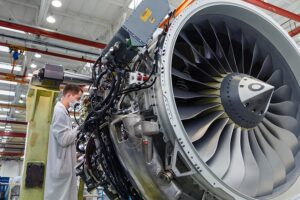 |
| PD-35 |
The Russian PD-35 engine, which had originally been developed for the wide-body long-haul airliner COMAC CR929, will be employed in the energy sector and in transport aircraft for carrying cargo.
The PD-35 turbofan engine, which is currently in development by the United Engine Corporation (UEC) of Russia, is intended for future use in both military and commercial transport aircraft. The Russian aviation industry considers this engine to be a critical undertaking. It is intended to provide a thrust range of 24 to 40 tonnes (239 kN to 398 kN), with the potential for upgrades to reach 50 tonnes.
Dmitry Markovich, Director of the Institute of Thermophysics at SBRAS, recently stated, “Now, the Chinese have decided to develop it themselves. This is a gas generator that can be implemented in other industries, and we, along with several other institutes of the Siberian Branch of the Russian Academy of Sciences (SBRAS), are involved in this work. It is now being developed for other fields, specifically for transport aviation, not for passenger transportation.”
The scientist did not specify which transport aircraft would use the PD-35; however, prior reports indicated that it could be applied to the An-124-100 “Ruslan.”
The powerplant was previously proposed for the Il-96-400M. Previously, Altitude Addicts had reported that Russia had decided to build the older version of the Il-96-300 with PS-90 engines. PD-35 engines are not enough to power the Il-96-400 version. Russia is also expected to make a jumbo jet with two crew. It is not known if the aircraft will require a higher-powered engine.
Concurrently, the Il-96 will function as a flying laboratory for experimental purposes. It is possible that the Il-96-400 may be converted into a flying laboratory.
The Il-96 also has a transport version known as the Il-96-400T.
The PD-35 will incorporate approximately 18 new technological advancements, including advanced digital design techniques, lightweight materials, heat-resistant coatings, and additive manufacturing. The engine has a fan diameter of 3.1 meters. UEC-UMPO, UEC-Aviadvigatel, UEC-Perm Motors, UEC-Naro-Fominsk Machine-Building Plant (NFMZ), UEC-Salyut, UEC-STAR, and ABRIS are among the numerous Russian companies that are contributing to its component supply. The Central Institute of Aviation Motors (CIAM) near Moscow is scheduled to conduct the subsequent phase of demonstrator testing following the initial evaluations. This phase will build upon the bench tests that have already been conducted on the PD-35 core engine. The PD-35, which is part of a larger family of engines, is designed to enhance the domestic aviation industry in Russia and is the nation’s first foray into the production of gas turbine engines in the 35-ton thrust category. The Russian government has confirmed its dedication to the successful implementation of the PD-35 project.
It is anticipated that the PD-35 will be produced in industrial quantities within the next five years. The engine’s prototype has already been subjected to effective testing.
The United Engine Corporation (UEC) has been developing the PD-35 at the “Aviadvigatel” (Perm) and “Saturn” (Rybinsk) factories since 2016. With a thrust of up to 35 tons, this engine is substantially more powerful than the PD-14, which was specifically designed for the narrow-body MC-21.
The PD-8 engine is another significant engine that is currently under development. The video of the transfer of the first PD-8 engines for installation on the SJ-100 short-haul liner has been released by the United Engine Corporation. Flight evaluations of the aircraft’s power plants will commence subsequent to the conclusion of groundwork. The demonstration flights are anticipated to take place in March.
 |
| PD-8 Engine Delivery |
Vladimir Artyakov, First Deputy General Director of the State Corporation Rostec, told the media, “Rostec enterprises are rapidly completing the import substitution program for the main systems and components of the SJ-100 aircraft. The PD-8 engines have been delivered to our aircraft manufacturers in Komsomolsk-on-Amur, who, together with representatives of the United Engine Corporation, will carry out final adjustments directly at the plant and prepare the aircraft for its first flight with domestically produced power units. Our goal is to begin flight testing and certification of a fully domestic airliner as soon as possible,”
Advanced technologies and the most recent domestic materials were employed to develop the PD-8 dual-circuit turbofan engine at the ODK-Saturn enterprise. The power plant was developed using the knowledge gained from the development of a more potent PD-14 engine.
The Be-200 amphibious aircraft will also be able to use the PD-8 in the future due to its features. However, the company has not released the specifications of the engine. Furthermore, UEC specialists are presently engaged in the development of a domestic power plant for heavy transport helicopters that is based on the PD-8.
Official Website of Youtube Channel – Altitude Addicts

